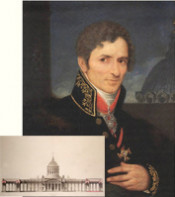
Birth of Andrey N. Voronikhin, eminent Russian architect
17 (28) October 1759 in the Urals, in the village of New Usolye, Solikamsky district, the Perm province, into a family of serfs was born Andrew Nikiforovich Voronikhin, a Russian architect and painter, representative of classicism, one of the founders of the Russian Empire style.
Voronikhin received his initial education at Stroganov icon workshop of Gavrila Yushkov. Young talent caught the attention of A. S. Stroganov, and in 1777 the count sent Voronikhin to study in Moscow. The development of original talent of self-taught artist was greatly influenced by then known architects Bazhenov and Kazakov.
At the end of 1779 by order of Stroganov, Voronikhin arrived to St. Petersburg, and then, with count’s son Pavel Stroganov, made a trip over Russia, Ukraine and Crimea.
In 1786, Andrew Nikiforovich was given his freedom and went to Switzerland and France, where he became acquainted with the monuments of European architecture. In addition, he studied mathematics, natural science, astronomy and mechanics.
At the end of 1790 Stroganov instructed Voronikhin rework interiors of his palace. In 1795-1796 Andrew Voronikhin was engaged in reconstruction of count’s dacha and construction of a pier; he constructed small cottages for P. A. Stroganov, beautified the park between the Bolshaya Nevka and Chernaya River in the New Village. These early architectural works by Voronikhin are notable for the clarity of composition, grace and refinement of details.
In 1797, the architect was awarded the title of academician of perspective and miniature painting for his "View of the Gallery in the Stroganov Palace" and "View of the Stroganov dacha."
In 1800, for the design of galleries near the bucket of Samson, the obelisk and fountains in Peterhof Park, Voronikhin was awarded the rank of architect by the Academy of Fine Arts, at the same time, he began his teaching career; in 1802 became professor and in 1811 - senior professor of architecture, the head of the architectural class.
In 1800, Andrew Voronikhin started working on his most famous project - the Cathedral of Our Lady of Kazan in St. Petersburg. The architectural competition for the construction of the cathedral was attended by such great architects as P. Gonzaga, C. Cameron, Thomas de Tomon, D. Quarenghi, N. A. Lvov. But of all the designs in 1800 was approved the plan by architect Voronikhin.
The laying of the foundation stone of the cathedral took place on 27 March (April 8), 1801, the works were completed in 1811. On the occasion of the consecration of the temple, Voronikhin was awarded the Order of St. Anne, 2nd class and a lifetime pension.
In parallel with the construction of the Kazan Cathedral, Alexander Voronikhin participated in the construction of several buildings in Pavlovsk in 1806; in 1806-1811 he constructed the building of the Mining Institute. In addition, Voronikhin worked on large projects of two monuments to the Patriotic War of 1812: Christ the Savior Cathedral in Moscow and a column of guns captured from the French. This work was interrupted by a sudden death of the architect.
Alexander N. Voronikhin died February 21 (March 5), 1814 in St. Petersburg and was buried at St. Lazar Cemetery of the Alexander Nevsky Lavra.
Lit.: Гримм Г. Г. Архитектор Воронихин. Л.; М., 1963; Кузнецов С. О. Дворцы и дома Строгоновых. Три века истории. М.; СПб, 2008; Лисовский В. Г. Андрей Воронихин. Л., 1971; Панов В. А. Архитектор А. Н. Воронихин. М., 1937; Шуйский В. К. Андрей Воронихин // Зодчие Санкт-Петербурга. XIX — начало XX века. СПб., 1998. С. 19—38.
Based on the Presidential Library’s materials:
Русские самородки в жизнеописаниях и изображениях. СПб., 1910. Вып. 6;
Чертежи А. Н. Воронихина: коллекция Музея архитектуры. М., 1938;

